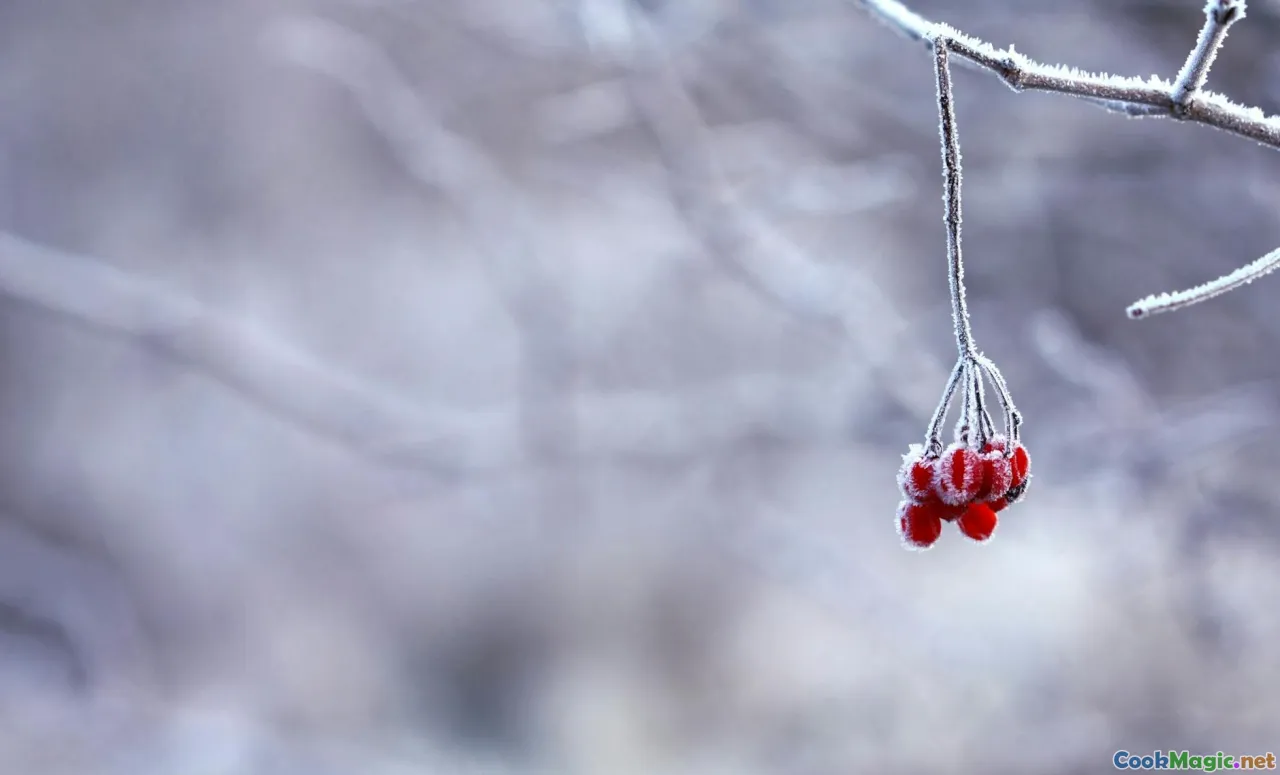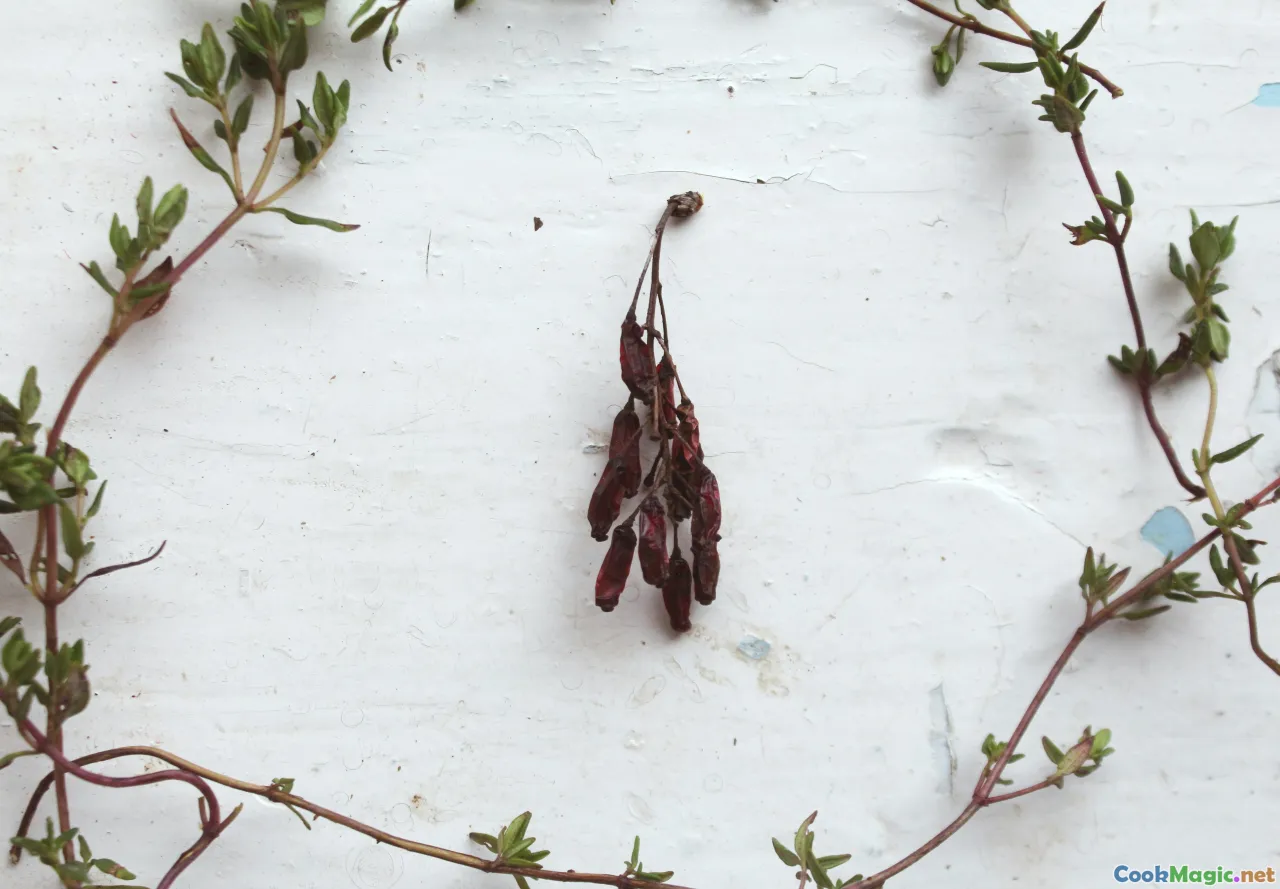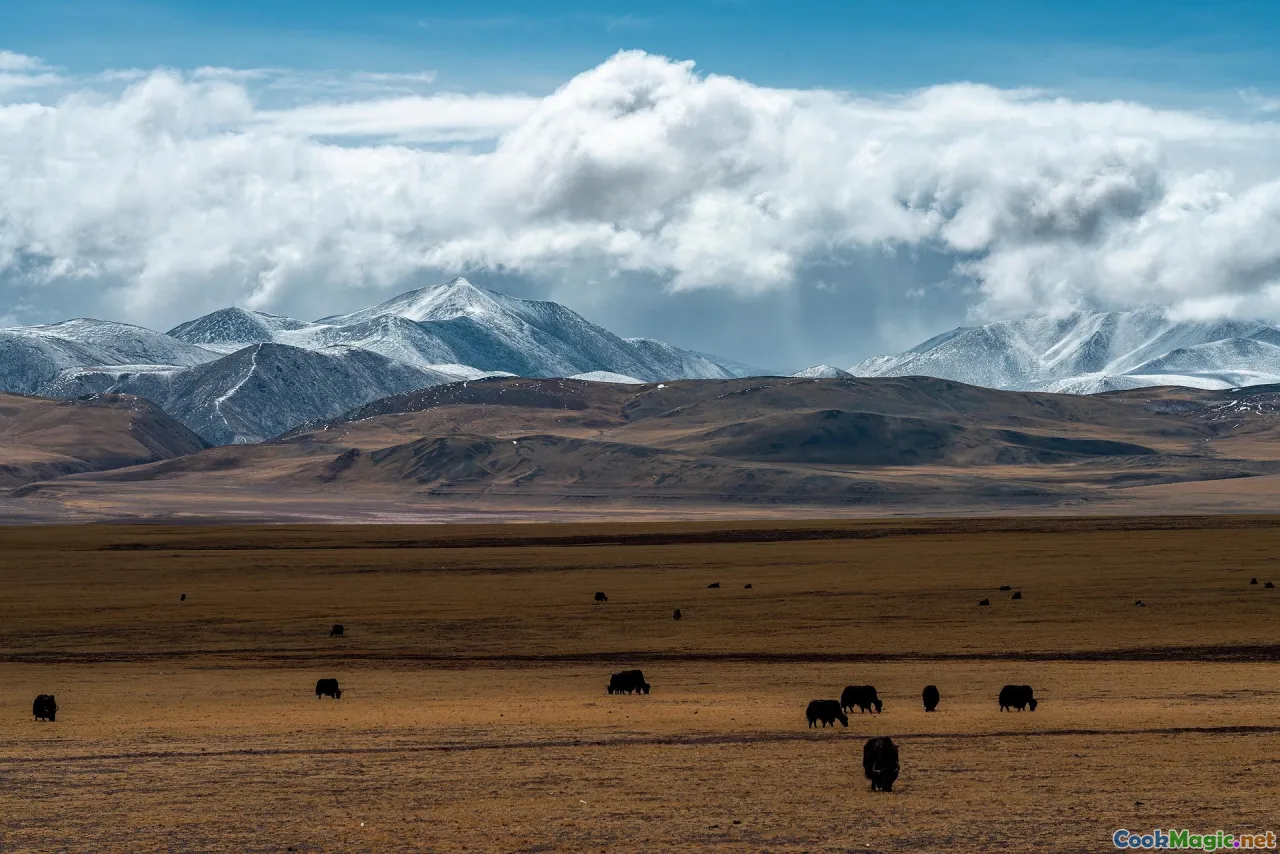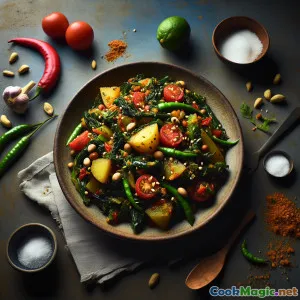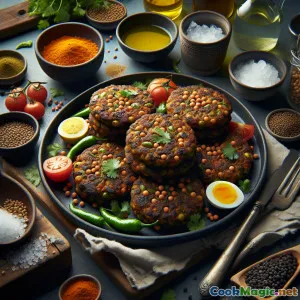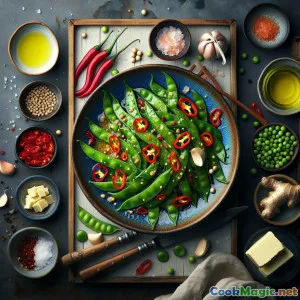
スノーピーの芽をピリ辛ヤクバターで
(Snow Pea Shoots in Fiery Yak Butter)
(0 レビュー)材料
-
300 grams スノーピーの芽(つる状/ドウミャオ)
(Rinse and spin dry; large stems trimmed)
-
3 tbsp ヤクバター
(Unsalted; substitute cultured butter or ghee if needed)
-
1 tsp 中性油
(Helps raise smoke point of butter)
-
2 pieces 新鮮な赤唐辛子
(Thinly sliced; adjust to heat preference)
-
3 cloves ニンニク
(薄切り)
-
15 grams 生姜
(Cut into fine matchsticks)
-
0.5 tsp ヒマラヤンピンクソルト
(Or fine sea salt, to taste)
-
0.25 tsp ホワイトペッパー
(For gentle heat and aroma)
-
1 tsp レモンジュース
(A bright finish to balance richness)
-
2 tsp 炒りごま
(For nutty crunch)
-
0.25 tsp 挽き花椒
(Optional numbing citrusy note)
(Rinse and spin dry; large stems trimmed)
(Unsalted; substitute cultured butter or ghee if needed)
(Helps raise smoke point of butter)
(Thinly sliced; adjust to heat preference)
(薄切り)
(Cut into fine matchsticks)
(Or fine sea salt, to taste)
(For gentle heat and aroma)
(A bright finish to balance richness)
(For nutty crunch)
(Optional numbing citrusy note)
栄養
- 分量: 2
- 1人分の量: 1 ボウル (200g)
- Calories: 320 kcal
- Carbohydrates: 0 g
- Protein: 6 g
- Fat: 28 g
- Fiber: 3 g
- Sugar: 3 g
- Sodium: 420 mg
- Cholesterol: 60 mg
- Calcium: 120 mg
- Iron: 2 mg
作り方
-
1 - Prep the pea shoots:
Rinse snow pea shoots in cold water, shake dry, and trim any thick or woody stems. Pat dry thoroughly to prevent splatter during stir-fry.
-
2 - Slice aromatics:
Thinly slice the red chillies and garlic; julienne the ginger. Measure remaining seasonings so you can work quickly once the wok is hot.
-
3 - Heat wok and fats:
Heat a wok or large skillet over high heat until just smoking. Add neutral oil, then yak butter; swirl until melted and foamy without browning.
-
4 - Bloom chilli, garlic, and ginger:
Add chillies, garlic, and ginger. Stir-fry 30–45 seconds until fragrant and lightly sizzling; avoid browning the garlic.
-
5 - Flash-stir-fry the shoots:
Add pea shoots in two quick batches, tossing constantly so they wilt evenly. Sprinkle salt and white pepper as they collapse and turn glossy.
-
6 - Optional fragrant lift:
If using, scatter crushed Sichuan peppercorn for a citrusy, numbing lift. Toss to distribute while the shoots are still sizzling.
-
7 - Finish and balance:
Remove from heat. Add a small squeeze of lemon juice to cut richness. Taste and adjust salt or heat to preference.
-
8 - Plate and Garnish:
Transfer immediately to a warm plate. Sprinkle toasted sesame seeds for texture. Serve hot while still bright and tender-crisp.
Rinse snow pea shoots in cold water, shake dry, and trim any thick or woody stems. Pat dry thoroughly to prevent splatter during stir-fry.
Thinly slice the red chillies and garlic; julienne the ginger. Measure remaining seasonings so you can work quickly once the wok is hot.
Heat a wok or large skillet over high heat until just smoking. Add neutral oil, then yak butter; swirl until melted and foamy without browning.
Add chillies, garlic, and ginger. Stir-fry 30–45 seconds until fragrant and lightly sizzling; avoid browning the garlic.
Add pea shoots in two quick batches, tossing constantly so they wilt evenly. Sprinkle salt and white pepper as they collapse and turn glossy.
If using, scatter crushed Sichuan peppercorn for a citrusy, numbing lift. Toss to distribute while the shoots are still sizzling.
Remove from heat. Add a small squeeze of lemon juice to cut richness. Taste and adjust salt or heat to preference.
Transfer immediately to a warm plate. Sprinkle toasted sesame seeds for texture. Serve hot while still bright and tender-crisp.
スノーピーの芽をピリ辛ヤクバターで :の詳細
Overview
Snow Pea Shoots with Red Chilli Yak Butter is a vivid, five-minute stir-fry that merges the grassy sweetness of tender pea tendrils with the warming, round richness of yak butter. The recipe honors Himalayan pantry wisdom—using robust dairy to fuel high-altitude life—while leaning on a Chinese-style wok technique often used for delicate greens. The result is a side dish that’s simultaneously airy and indulgent: silky leaves, crisp-tender stems, and ribbons of aromatic chilli, garlic, and ginger.
Why it Works
- Yak butter has a fuller, slightly gamier personality than cow’s butter, delivering depth without the heaviness of cream-based sauces. In a hot wok, it coats the pea shoots with a delicate gloss, carrying chilli and ginger perfumes into every bite.
- Flash stir-frying protects the shoots’ vibrant color and springy texture. Because they cook in under two minutes, the greens stay sweet and lively rather than limp.
- A touch of acidity (lemon) reins in richness, while optional Sichuan peppercorn offers a modern, citrusy sparkle that nods to cross-border spice routes.
Ingredient Notes
- Snow pea shoots (dou miao) are the tender leaves, tips, and tendrils of the pea plant. They cook far faster than mature greens. Seek bunches with fine, delicate stems and no yellowing.
- Yak butter is traditional across Tibetan and Nepali highlands—famed in tea but equally compelling in savory cookery. If unavailable, cultured cow’s butter or ghee stands in beautifully. Ghee will brown less readily, helpful for high heat.
- Fresh red chillies bring a clean, fragrant heat. Choose milder long red chillies for a tingle or bird’s eye for fireworks.
Technique Tips
- Dry the shoots very well. Residual water dulls searing and can cause the butter to sputter and break.
- Combine a teaspoon of neutral oil with yak butter. The oil nudges up the working smoke point, letting you stir-fry hot and fast without scorching dairy solids.
- Add aromatics before the greens, but keep them pale. You’re coaxing fragrance—not making chilli-garlic chips.
- Work in batches if your wok is small; crowding steams the greens.
Flavor Tweaks and Substitutions
- No yak butter? Use 2 tbsp cultured butter plus 1 tbsp ghee for depth and stability. Vegan? Try a high-quality plant butter and a drizzle of toasted sesame oil at the end.
- For extra nuttiness, finish with toasted sesame seeds or crushed roasted peanuts.
- Prefer smoky heat? Swap in a teaspoon of chilli crisp or use one dried chilli toasted lightly in the fat.
- Boost umami with a splash of tamari (gluten-free) or a few drops of fish sauce if you’re not keeping it vegetarian—add at the finish to preserve brightness.
Serving Ideas
- Serve alongside steamed rice, tingmo (Tibetan steamed bread), or butter tea noodles for a comforting Himalayan-influenced meal.
- Pair with grilled trout, roasted mushrooms, or a simple lentil dal for a balanced plate.
- As a brunch topper, crown a bowl of soft polenta or scrambled eggs—its chilli-butter perfume is irresistible.
Cultural Context
In the Himalayan world, yak butter is both sustenance and symbol—a staple of warmth, hospitality, and resilience. While the global spotlight often falls on butter tea, households also use yak dairy to sauté greens, stretch soups, and finish breads. Snow pea shoots, more commonly associated with Chinese stir-fry technique, create a beautiful meeting point: the greens’ quick-cooking nature fits the fast, fuel-efficient cooking methods favored in high-altitude kitchens, while the butter’s richness mitigates the chill of mountain evenings. This dish celebrates that confluence—Tibetan and Nepali dairy heritage with wok-fire speed.
Sourcing and Seasonality
Pea shoots peak in spring, though hydroponic or greenhouse varieties are available year-round in many markets. Yak butter is increasingly sold frozen online or at specialty Himalayan grocers; if you find it, look for a clean aroma and a pale yellow hue. Store tightly wrapped and use within a few months for best flavor.
Make-Ahead and Leftovers
This dish is at its best immediately off the heat, with the shoots still bright and the butter glossy. If you must reheat, do so briefly in a hot pan to avoid sogginess. Leftovers fold nicely into omelets or noodle bowls.
Chef’s Notes
This recipe is deceptively simple, so balance and tempo matter. Keep everything measured; move with confidence once the fat is hot. Season lightly—the butter and aromatics do the heavy lifting. Above all, chase that moment when the shoots just wilt, still vibrant and buoyant, so each bite tastes like the first tender day of spring, cloaked in mountain butter and a red chilli grin.

